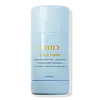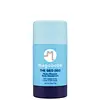What's inside
What's inside
 Key Ingredients
Key Ingredients

 Benefits
Benefits

 Concerns
Concerns

 Ingredients Side-by-side
Ingredients Side-by-side

Caprylic/Capric Triglyceride
MaskingCocos Nucifera Oil
MaskingTapioca Starch
Stearyl Alcohol
EmollientMagnesium Hydroxide
AbsorbentParfum
MaskingHydrogenated Castor Oil
EmollientOryza Sativa Bran Wax
Skin ConditioningBehenyl Alcohol
EmollientPolyglyceryl-3 Stearate
EmulsifyingMandelic Acid
AntimicrobialXylityl Sesquicaprylate
AntimicrobialAnhydroxylitol
HumectantMangifera Indica Seed Butter
Skin ConditioningPlatonia Insignis Seed Butter
EmollientTocopherol
AntioxidantCaprylic/Capric Triglyceride, Cocos Nucifera Oil, Tapioca Starch, Stearyl Alcohol, Magnesium Hydroxide, Parfum, Hydrogenated Castor Oil, Oryza Sativa Bran Wax, Behenyl Alcohol, Polyglyceryl-3 Stearate, Mandelic Acid, Xylityl Sesquicaprylate, Anhydroxylitol, Mangifera Indica Seed Butter, Platonia Insignis Seed Butter, Tocopherol
Caprylic/Capric Triglyceride
MaskingTapioca Starch
Stearyl Alcohol
EmollientButyrospermum Parkii Butter
Skin ConditioningSodium Bicarbonate
AbrasiveMagnesium Hydroxide
AbsorbentCocos Nucifera Oil
MaskingTriethyl Citrate
MaskingHydrogenated Castor Oil
EmollientHelianthus Annuus Seed Oil
EmollientBehenyl Alcohol
EmollientPolyglyceryl-3 Stearate
EmulsifyingEucalyptus Globulus Oil
Cedrus Atlantica Bark Oil
MaskingZinc Ricinoleate
Zinc Oxide
Cosmetic ColorantXylityl Sesquicaprylate
AntimicrobialLactobacillus Ferment
Skin ConditioningSilica
AbrasiveKaolin
AbrasiveAvena Sativa Kernel Flour
AbrasiveCichorium Intybus Seed Oil
AntioxidantHippophae Rhamnoides Fruit Oil
Skin ProtectingTocopherol
AntioxidantMagnesium Ascorbyl Phosphate
AntioxidantMentha Piperita Oil
MaskingBenzyl Acetate
MaskingCitronellol
PerfumingHexyl Cinnamal
PerfumingMethyl Salicylate
PerfumingMethyl Benzoate
PerfumingCoumarin
PerfumingHydroxycitronellal
PerfumingCarvone
MaskingLinalool
PerfumingTerpineol
MaskingMaltodextrin
AbsorbentAnhydroxylitol
HumectantCitrus Aurantifolia Oil
CleansingCaprylic/Capric Triglyceride, Tapioca Starch, Stearyl Alcohol, Butyrospermum Parkii Butter, Sodium Bicarbonate, Magnesium Hydroxide, Cocos Nucifera Oil, Triethyl Citrate, Hydrogenated Castor Oil, Helianthus Annuus Seed Oil, Behenyl Alcohol, Polyglyceryl-3 Stearate, Eucalyptus Globulus Oil, Cedrus Atlantica Bark Oil, Zinc Ricinoleate, Zinc Oxide, Xylityl Sesquicaprylate, Lactobacillus Ferment, Silica, Kaolin, Avena Sativa Kernel Flour, Cichorium Intybus Seed Oil, Hippophae Rhamnoides Fruit Oil, Tocopherol, Magnesium Ascorbyl Phosphate, Mentha Piperita Oil, Benzyl Acetate, Citronellol, Hexyl Cinnamal, Methyl Salicylate, Methyl Benzoate, Coumarin, Hydroxycitronellal, Carvone, Linalool, Terpineol, Maltodextrin, Anhydroxylitol, Citrus Aurantifolia Oil
 Reviews
Reviews

Ingredients Explained
These ingredients are found in both products.
Ingredients higher up in an ingredient list are typically present in a larger amount.
This ingredient is created from dehydrating xylitol in acidic conditions. Xylitol is a famous sugar and humectant.
Much like its predecessor, anhydroxylitol is a humectant. Humectants attract and hold water to moisturize the skin.
This ingredient is most commonly found in a popular trio called Aquaxyl. Aquaxyl is made up of anhydroxylitol (24 - 34%), xylitylglucoside (35 - 50%), and xylitol (5 - 15%).
According to a manufacturer, Aquaxyl is known for a 3-D hydration concept and an anti-dehydration shield to reinforce the outer layer of skin.
This ingredient is often derived from plants such as wood and sugarcane.
Learn more about AnhydroxylitolBehenyl Alcohol is a type of fatty alcohol (these are different from the drying, solvent alcohols).
Fatty Alcohols have hydrating properties and are most often used as an emollient or to thicken a product. They are usually derived from natural fats and oils; behenyl alcohol is derived from the fats of vegetable oils.
Emollients help keep your skin soft and hydrated by creating a film that traps moisture in.
In 2000, Behenyl Alcohol was approved by the US as medicine to reduce the duration of cold sores.
Learn more about Behenyl AlcoholThis ingredient is an emollient, solvent, and texture enhancer. It is considered a skin-softener by helping the skin prevent moisture loss.
It helps thicken a product's formula and makes it easier to spread by dissolving clumping compounds.
Caprylic Triglyceride is made by combining glycerin with coconut oil, forming a clear liquid.
While there is an assumption Caprylic Triglyceride can clog pores due to it being derived from coconut oil, there is no research supporting this.
Learn more about Caprylic/Capric TriglycerideCocos Nucifera Oil is obtained from the kernels of the coconut fruit. In other words, this is coconut oil.
Coconut Oil is rich in fatty acids with lauric acid making up the majority of these. It also contains linoleic acid. Due to this high fatty acid content, coconut oil helps trap moisture and soften skin.
Despite being antibacterial, coconut oil may not be great for acne-prone skin. It is comedogenic and may clog pores. This ingredient may not be safe for malassezia or fungal acne.
Note: Coconut Oil should not replace your sunscreen for UV protection. Studies show it only blocks about 20% of UV.
This oil is non-volatile and has a light scent.
The term 'fragrance' is not regulated in many countries. In many cases, it is up to the brand to define this term. For instance, many brands choose to label themselves as "fragrance-free" because they are not using synthetic fragrances. However, their products may still contain ingredients such as essential oils that are considered a fragrance.
Learn more about Cocos Nucifera OilHydrogenated Castor Oil is created by adding hydrogen to castor oil. This helps stabilize the castor oil and raises the melting point. At room temperature, hydrogenated castor oil is solid.
Castor Oil helps moisturize the skin. It is rich in a fatty acid called ricinoleic acid. This fatty acid helps prevent moisture loss on the skin. This helps keep your skin soft and hydrated. Ricinoleic acid also has anti-inflammatory and pain reducing properties.
As a wax-like substance, Hydrogenated Castor Oil acts as an emollient. Emollients help keep your skin stay soft and smooth by creating a barrier. This barrier helps trap moisture.
Hydrogenated Castor Oil may not be fungal-acne safe. We recommend speaking with a professional.
Learn more about Hydrogenated Castor OilWe don't have a description for Magnesium Hydroxide yet.
This ingredient comes from glycerin and stearic acid. It has emulsifying properties.
Due to its stearic acid (which is a fatty acid) base, this ingredient may not be Malassezia folliculitis, or fungal acne, safe.
Stearyl Alcohol is a type of fatty alcohol from stearic acid. It is a white, waxy compound used to emulsify ingredients.
Fatty Alcohols are most often used as an emollient or to thicken a product. Emollients help soothe and hydrate the skin by trapping moisture.
They are usually derived from natural fats and oils and therefore do not have the same drying or irritating effect as solvent alcohols. FDA allows products labeled "alcohol-free" to have fatty alcohols.
Learn more about Stearyl AlcoholTapioca starch is a thickening agent and is made from the cassava root, also known as yucca.
According to a manufacturer, it is an excellent talc replacement.
It is gluten-free.
Learn more about Tapioca StarchTocopherol (also known as Vitamin E) is a common antioxidant used to help protect the skin from free-radicals and strengthen the skin barrier. It's also fat soluble - this means our skin is great at absorbing it.
Vitamin E also helps keep your natural skin lipids healthy. Your lipid skin barrier naturally consists of lipids, ceramides, and fatty acids. Vitamin E offers extra protection for your skin’s lipid barrier, keeping your skin healthy and nourished.
Another benefit is a bit of UV protection. Vitamin E helps reduce the damage caused by UVB rays. (It should not replace your sunscreen). Combining it with Vitamin C can decrease sunburned cells and hyperpigmentation after UV exposure.
You might have noticed Vitamin E + C often paired together. This is because it is great at stabilizing Vitamin C. Using the two together helps increase the effectiveness of both ingredients.
There are often claims that Vitamin E can reduce/prevent scarring, but these claims haven't been confirmed by scientific research.
Learn more about TocopherolXylityl Sesquicaprylate is used for its gentle antimicrobial properties. It also helps moisturize the skin as a humectant.
One part of Xylityl Sesquicaprylate is mono and diesters of caprylic acid. Caprylic Acid is a fatty acid. The other part is hexitol anhydrides derived from xylitol. Xylitol is a natural sugar found in fruits and vegetables.
As a humectant, Xylityl Sesquicaprylate helps attract water to your skin. This helps with increasing hydration for your skin.
Learn more about Xylityl Sesquicaprylate